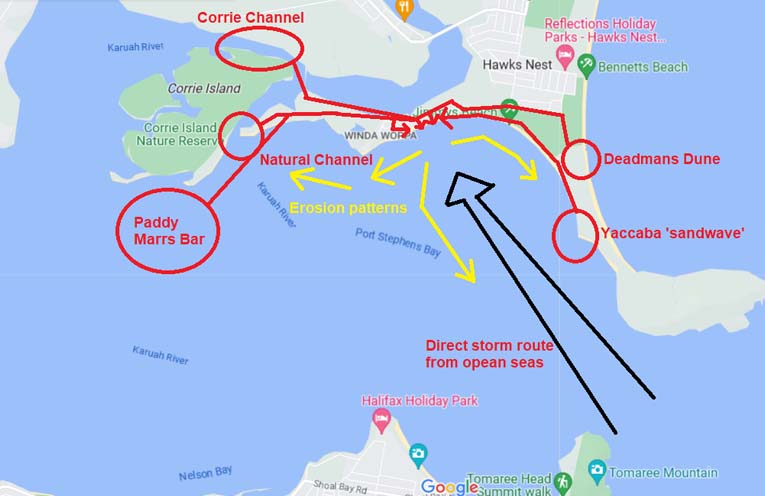
EROSION at Jimmys Beach stubbornly persists, a reminder of the highly dynamic system that constitutes Port Stephens as a whole.
In 1967, residential development at Winda Woppa involved artificial reprofiling of the dune to build the road, and resultant vegetation destruction.
Two decades later, Mother Nature’s slow, inexorable forces prompted a series of renourishment campaigns, the next due on 15 May.
A widely-quoted 2012 report by BMT-WBM cites a dozen renourishment attempts between 1984 and mid-2012.
Renourishment sand has been sourced from all over the Bay system, including around Corrie Island, Yacabba ‘Sandwave’, Paddy Marrs Bar, and the eastern ‘Natural Channel’ between Winda Woppa and Corrie.
The most ecologically devastating, by far, were the multiple ‘Deadmans’ operations between 1999-2007, with “Several rounds of emergency works, typically 3000-8000m3 per year, taken (by truck) from Deadmans sand dune,” according to BMT-WBM.
“Deadmans suffered environmental vandalism, and the roads around Hawks Nest were torn up by 120 truck movements per day,” the Myall River Action Group’s Gordon Grainger explained.
“At the time, they needed an emergency source, but the Deadmans sand, likely deposited from the oceanside of Bennetts long ago, meant that the trucking introduced more sand into the Bay’s system,” Richard Streamer, President of the Winda Woppa Preservation Association (WWPA), told NOTA.
Neither community group can ignore that the introduction of more sand to the Bay’s system was highly detrimental.
“It is not the only reason that the Myall River mouth is silting up, but some of the sand eroded from Jimmys would have moved towards the river mouth at the Natural Channel,” Mr Streamer said.
“Depending on weather conditions, Jimmys sand can move east or west along the beach, or straight out towards the heads, highlighting the dynamic nature of the system.”
The last 30 years’ numerous individual studies, each performed at various points and times around the system, have not been comprehensively and scientifically consolidated, so the information avalanche remains too unclear to guide decisive and purposeful future actions.
By Thomas O’KEEFE



